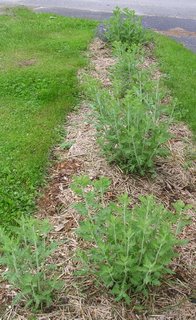
2 3/4 just in the last 36 hours. Rain is the top news story here at Henbogle. Today at last, we had a break from the rain; there was even a short-lived ray of weak sunshine near mid-day. After all this rain, though, we can definitively say, that Henbogle House does not leak. The chicken palace is as dry as it can be when inhabited by 6 chickens in 98% humidity. The girls

did get outside a bit today, and seem very pleased to be out, running about and flapping their wings. The ground in their pen is pretty wet, but there are no puddles yet. I wish I could say that for the vegetable garden.
This morning, there was standing water in the garden, particularly in the potato patch. The potatoes, planted 2 weeks ago, have yet to sprout, and I’m wondering if they will given all this rain. In addition to the wet, the wretched dog has been roaming about in there, leaving deep,

muddy footprints. Arghh. The broccoli and cauliflower, however, look good I am happy to report. The floating row cover seems to be protecting them from the evil groundhogs next door. Apparently, they do not like going under the covers. This worked for the lettuce bed in the past, and so far so good for the cole crops.
As for the rest of the garden, it is in a sad state. It was weedy before we went away last

weekend, but 7 days and 6 inches of rain later, it looks like weeds are our primary crop. Ugh. More rain is forecast right through the weekend, and it is so muddy and wet I’m afraid to get in there and weed, let alone try and plant the rest of the crops. Hmmm.

The ornamental gardens don’t look so bad; in fact, the new hemlocks seem to be soaking this right up, although their neighbors the hybrid lilacs are looking a bit beat up, and the new seedlings of oriental poppy, echinacea cv. White Swan, and

nicotiana I added to the extension of the side border have been mashed into pulp -- their survival does not look likely. Most of the other plants look lush and green, with the exception of a few that have been beaten down. The perennial flax is having a very bad hair day – it usually shines with lady’s mantle and mountain bluet.
Our new gardens (formerly front lawn) are filling in nicely, although I have some tweaking to do still. The asitlbe is exceptionally happy here, thus are taking over so I need to give them some more room. The Northern Lights series azalea cv.

Lemon Lights which I bought last year is a surprise, being a very orange shade of yellow. I guess it serves me right, as I purchased it at the end of the season at deep discount from an evil big box store. I am guessing it is a Mandarin Lights azalea. The original plan called for the astilbes to move in front of the azalea once it grew a bit, but I’m re-thinking this now that I need to replace the azalea, orange not being one of my colors. Maybe back near the new purple ninebark? That might look nice together.

The butterfly bush is finally leafing out, I was afraid I’d killed it after all. I’m now wondering if I cut it back too hard this spring. The Russian Sage, on the other hand, is coming along splendidly, really

filling in to form a nice low summer hedge, exactly as I was hoping it would. Something is right with the garden, rain be damned.
 (one of my favorite scenes was this misty water feature) but the gardens and grounds at the Institute for Ecosystem Studies was a close second. We also toured the Vanderbilt Mansion in Hyde Park -- very posh but so stiffly formal it is like stepping into a painting, not a garden.
(one of my favorite scenes was this misty water feature) but the gardens and grounds at the Institute for Ecosystem Studies was a close second. We also toured the Vanderbilt Mansion in Hyde Park -- very posh but so stiffly formal it is like stepping into a painting, not a garden.



















































